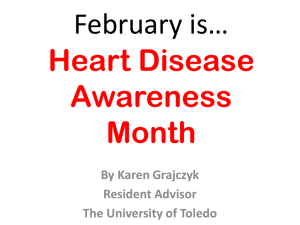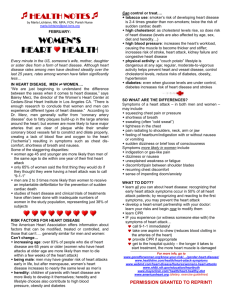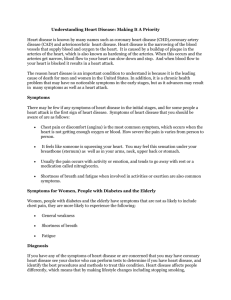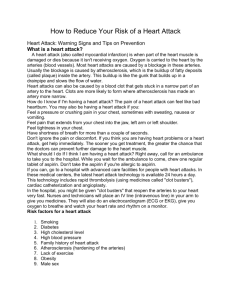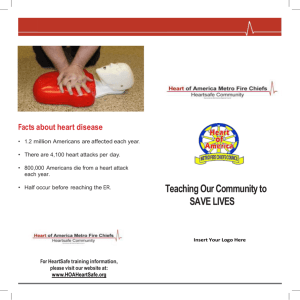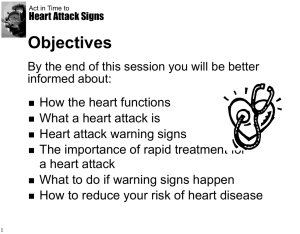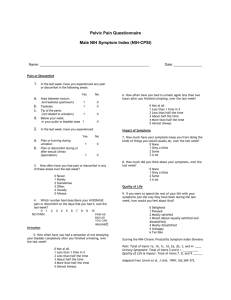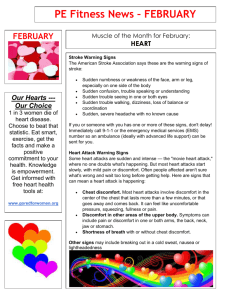February Heart Disease
advertisement
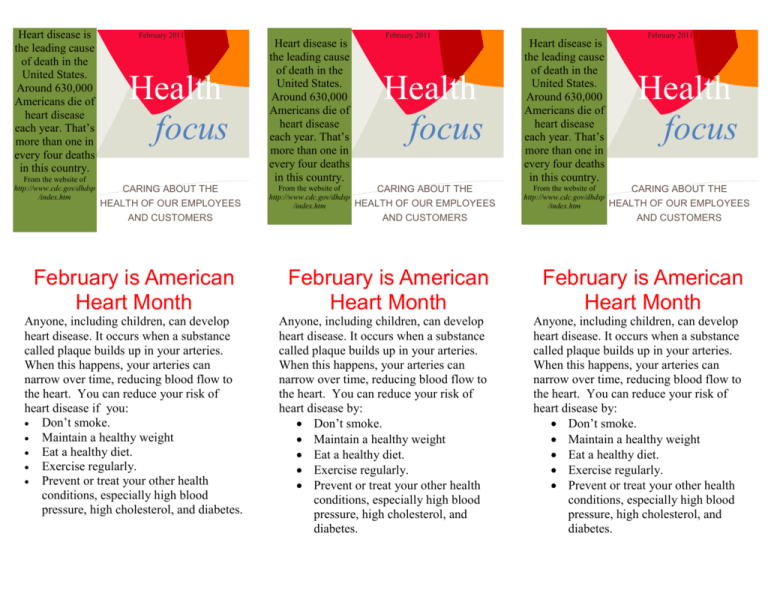
Heart disease is the leading cause of death in the United States. Around 630,000 Americans die of heart disease each year. That’s more than one in every four deaths in this country. From the website of http://www.cdc.gov/dhdsp /index.htm February 2011 Health focus CARING ABOUT THE HEALTH OF OUR EMPLOYEES AND CUSTOMERS H February is American Heart Month Anyone, including children, can develop heart disease. It occurs when a substance called plaque builds up in your arteries. When this happens, your arteries can narrow over time, reducing blood flow to the heart. You can reduce your risk of heart disease if you: Don’t smoke. Maintain a healthy weight Eat a healthy diet. Exercise regularly. Prevent or treat your other health conditions, especially high blood pressure, high cholesterol, and diabetes. February 2011 Heart disease is the leading cause of death in the United States. Around 630,000 Americans die of heart disease each year. That’s more than one in every four deaths in this country. From the website of http://www.cdc.gov/dhdsp /index.htm Health focus CARING ABOUT THE HEALTH OF OUR EMPLOYEES AND CUSTOMERS H February 2011 Heart disease is the leading cause of death in the United States. Around 630,000 Americans die of heart disease each year. That’s more than one in every four deaths in this country. From the website of http://www.cdc.gov/dhdsp /index.htm Health focus CARING ABOUT THE HEALTH OF OUR EMPLOYEES AND CUSTOMERS H February is American Heart Month February is American Heart Month Anyone, including children, can develop heart disease. It occurs when a substance called plaque builds up in your arteries. When this happens, your arteries can narrow over time, reducing blood flow to the heart. You can reduce your risk of heart disease by: Don’t smoke. Maintain a healthy weight Eat a healthy diet. Exercise regularly. Prevent or treat your other health conditions, especially high blood pressure, high cholesterol, and diabetes. Anyone, including children, can develop heart disease. It occurs when a substance called plaque builds up in your arteries. When this happens, your arteries can narrow over time, reducing blood flow to the heart. You can reduce your risk of heart disease by: Don’t smoke. Maintain a healthy weight Eat a healthy diet. Exercise regularly. Prevent or treat your other health conditions, especially high blood pressure, high cholesterol, and diabetes. What are the signs and symptoms? Someone having a heart attack may experience several symptoms, including: Chest pain or discomfort that doesn’t go away after a few minutes. Pain or discomfort in the jaw, neck, or back. Weakness, light-headedness, nausea (feeling sick to your stomach), or a cold sweat. Pain or discomfort in the arms or shoulder. Shortness of breath. If you think that you or someone you know is having a heart attack, call 9-1-1 immediately. Consider this... In a 2005 survey, most respondents— 92%—recognized chest pain as a symptom of a heart attack. Only 27% were aware of all major symptoms and knew to call 9-1-1 when someone was having a heart attack.4 About 47% of sudden cardiac deaths occur outside a hospital. This suggests that many people with heart disease don't act on early warning signs. For more information, see http://www.cdc.gov/heartdisease/attract new employees in a competitive market. University of Wisconsin, U.S. Department of Agriculture and Wisconsin Counties cooperating. UW-Extension provides equal opportunities in employment and programming including Title IX and ADA. What are the signs and symptoms? What are the signs and symptoms? Someone having a heart attack may experience several symptoms, including: Chest pain or discomfort that doesn’t go away after a few minutes. Pain or discomfort in the jaw, neck, or back. Weakness, light-headedness, nausea (feeling sick to your stomach), or a cold sweat. Pain or discomfort in the arms or shoulder. Shortness of breath. If you think that you or someone you know is having a heart attack, call 9-1-1 immediately. Someone having a heart attack may experience several symptoms, including: Chest pain or discomfort that doesn’t go away after a few minutes. Pain or discomfort in the jaw, neck, or back. Weakness, light-headedness, nausea (feeling sick to your stomach), or a cold sweat. Pain or discomfort in the arms or shoulder. Shortness of breath. If you think that you or someone you know is having a heart attack, call 9-1-1 immediately. Consider this... Consider this... In a 2005 survey, most respondents— 92%—recognized chest pain as a symptom of a heart attack. Only 27% were aware of all major symptoms and knew to call 9-1-1 when someone was having a heart attack.4 About 47% of sudden cardiac deaths occur outside a hospital. This suggests that many people with heart disease don't act on early warning signs. In a 2005 survey, most respondents— 92%—recognized chest pain as a symptom of a heart attack. Only 27% were aware of all major symptoms and knew to call 9-1-1 when someone was having a heart attack.4 About 47% of sudden cardiac deaths occur outside a hospital. This suggests that many people with heart disease don't act on early warning signs. For more information, see http://www.cdc.gov/heartdisease/ For more information, see http://www.cdc.gov/heartdisease/ University of Wisconsin, U.S. Department of Agriculture and Wisconsin Counties cooperating. UW-Extension provides equal opportunities in employment and programming including Title IX and ADA. University of Wisconsin, U.S. Department of Agriculture and Wisconsin Counties cooperating. UW-Extension provides equal opportunities in employment and programming including Title IX and ADA.
